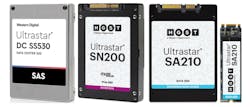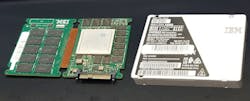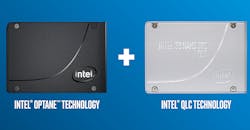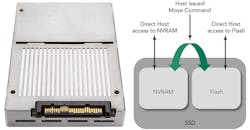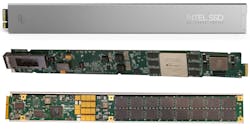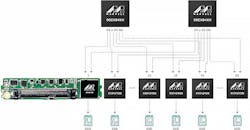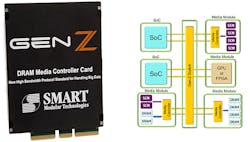This year’s Flash Memory Summit (FMS) could be called the Summit of NVMe. NVMe is based on PCI Express providing a memory access protocol to non-volatile memory (NVM). This is typically flash memory, but there are other alternatives. NVM is also used for solid-state drives (SSDs) that support protocols like SATA and SAS.
The activity at FMS was furious and the show floor actually opened this year. Last year, a fire managed to put a damper on things. Given this year’s level of activity, it will be hard to cram all of the new items and technologies on display at the show. The following runs down some of the major highlights. Coming soon will be additional articles targeting many of these in more detail.
Western Digital SATA, SAS, and NVMe
1. Western Digital exhibited its SATA, SAS, and NVMe drives at the Flash Memory Summit.
FMS was host to every NVM form factor, such as some of Western Digital’s Ultrastar flash storage devices (Fig. 1). NVMe was center stage, but SATA and SAS drives were available as well. SATA and SAS remains a key component for embedded designers as well as in the data center. However, NVMe is quickly taking over in the data center.
Form factors like U.2 are allowing Western Digital’s NVMe SN200 to deliver capacities up to 7.68 TB per drive and read performance of over 1.2M IOPS using PCI Express Gen 3 at 1 disk write (DW)/Day (D). The SAS SS530 packs in 15.36 TB at 1 DW/D with a 12-Gb/s SAS interface. The SA210 targets the edge with up to 1.92 TB and a 6-Gb/s SATA interface.
IBM U.2 with MRAM
2. IBM’s FlashCore Module (FCM) NVMe packs in 19.2 TB of 64-layer, TLC flash memory along with an Everspin MRAM cache into the U.2 form factor.
Flash SSDs typically employ an on-board RAM cache with supercaps to allow for proper shut down. IBM took a different route using Everspin’s MRAM with its later enterprise drive (Fig. 2). The IBM FlashCore Module (FCM) NVMe drives pack in 19.2 TB of 64-layer, TLC flash memory along with Everspin 256-Mb STT-MRAM chips. MRAM eliminates the need for large supercaps in the drive. They support optional 3:1 data compression and are FIPS 140 compliant. The system uses a PCI Express Gen 4 interface.
The dual-port drives will be used in IBM’s FlashSystem 9100 family. These provide 10G Ethernet or 16-Gb/s Fibre Channel support.
Intel Optane and QLC
3. Intel looks to combine its Optane with QLC NAND flash memory.
Magnetoresistive RAM (MRAM) was getting more traction—in fact, an MRAM developers day took place before the start of FMS. On the other hand, MRAM isn’t the only NVM alternative to flash memory. Intel’s Optane is another, and it was out in force with support from multiple vendors.
Of course, Intel was highlighting Optane in conjunction with QLC flash storage (Fig. 3). Currently, Optane bests MRAM in price and capacity. It’s available in most NVM form factors from M.2 to U.2, and it’s even finding a home on the memory bus.
Radian RMS-350 Hybrid NVRAM and NVMe Flash
4. The Radian RMS-350 NVMe hybrid drive combines NVRAM and flash in a single package.
Don’t discount DRAM just yet. There were even more NVDIMM alternatives on display at FMS, as well as NVRAM solutions like Radian’s hybrid RMS-350 (Fig. 4). The RMS-350 combines NVRAM with flash using NVMe protocols for accessing both.
The NVRAM provides higher throughput and much faster write performance, allowing it to be used for certain applications. The flash side provides more capacity while being limited by write performance as is the case with most flash SSDs. There’s even a feature to move data from NVRAM to flash within the driver, providing faster operation and lower host overhead.
EDFSS Long Rulers
5. Intel’s EDFSS DC P4500 (top) delivers 8 TB of TLC NAND. Liteon’s ADX (bottom) with BiCS4 QLC NAND is another example of the EDFSS ruler format. Intel’s FPGA module (middle) is a research project that links the FPGA to another memory module.
One new form factor out in force at FMS was the Enterprise and Datacenter Storage Form Factor (EDSFF), also known as the “ruler” (Fig. 5). The EDSFF Working Group has all of the details. The EDSFF standard defines long (12 in.) and short (6 in.) versions; both have an NVMe interface.
The form factor is designed for storage, but that’s not the only thing that can be done with the system. Intel was showing off a unit that had an Altera FPGA instead of memory. The FPGA is actually a host, so that the PCI Express fabric would be configured to allow it to access memory in an adjacent slot.
EDSFF modules were being shown by a number of vendors, such as Liteon’s ADX with BiCS4 QLC NAND and Intel’s DC P4500 with 8 TB of TLC NAND.
Supermicro EDFSS Storage
6. These Supermicro systems support 32 EDFSS modules for up to 256 TB of NVMe storage.
Of course, EDFSS modules need to plug into something like Super Micro Computer’s (Supermicro) SSG-136-NR32JBF and the SYS-1029P-NR32R (Fig. 6). Both have 32 EDFSS slots. The difference is the processor and connectivity options available to developers.
The systems highlight the cooling advantage of the EDFSS modules that allow air to move easily from front to rear. The 1U systems provide hot-swap support and can pack in 256 TB of NVMe flash memory.
Wiwynn Repurposes M.2 NVMe
7. Wiwynn repurposes M.2 NVMe modules by plugging them into an NVMe drive frame.
Devices possessing an M.2 form factor could be seen everywhere. While one or two were situated on a motherboard, especially in compact devices, the modules were often found on cards and drive packages like the demo system from Wiwynn (Fig. 7).
Wiwynn sells a range of rack-mount systems, including those designed for NVMe drives. The demo replaced these drives with modules based on multiple M.2 modules.
Marvell NVMe-over-Fabric Controller
8. Marvell’s 88SN2400 NVMe-over-Fabric controller ties a NVMe drive to a 100-Gb/s Ethernet fabric.
The Supermicro servers mentioned earlier pack a lot of EDFSS rules into a 1U rack system, but data centers often have significantly more storage requirements that need more extensive connectivity. NVMe-over-Fabric (NVMe-oF) is one way to meet that demand (Fig. 8).
Marvell’s 88SN2400 NVMe-oF controller is designed to hook into this fabric, linking local storage to the fabric. The 88SN2400 integrates a 100-Gb/s Ethernet controller and connect a drive to the fabric. It supports up to 18M IOPS.
SMART Gen-Z
9. Gen-Z is another storage fabric. SMART Modular was showing off it Gen-Z hardware at the Flash Memory Summit.
NVMe-oF isn’t the only way people were connecting large amounts of NVM together. Gen-Z is another high-performance, low-latency fabric that has growing support (Fig. 9). The Gen-Z Consortium fosters the standard; its 1.0 specification was released in February. At FMS, SMART Modular Technologies was showing off its Gen-Z compatible hardware.
About the Author
William G. Wong
Senior Content Director - Electronic Design and Microwaves & RF
I am Editor of Electronic Design focusing on embedded, software, and systems. As Senior Content Director, I also manage Microwaves & RF and I work with a great team of editors to provide engineers, programmers, developers and technical managers with interesting and useful articles and videos on a regular basis. Check out our free newsletters to see the latest content.
You can send press releases for new products for possible coverage on the website. I am also interested in receiving contributed articles for publishing on our website. Use our template and send to me along with a signed release form.
Check out my blog, AltEmbedded on Electronic Design, as well as his latest articles on this site that are listed below.
You can visit my social media via these links:
- AltEmbedded on Electronic Design
- Bill Wong on Facebook
- @AltEmbedded on Twitter
- Bill Wong on LinkedIn
I earned a Bachelor of Electrical Engineering at the Georgia Institute of Technology and a Masters in Computer Science from Rutgers University. I still do a bit of programming using everything from C and C++ to Rust and Ada/SPARK. I do a bit of PHP programming for Drupal websites. I have posted a few Drupal modules.
I still get a hand on software and electronic hardware. Some of this can be found on our Kit Close-Up video series. You can also see me on many of our TechXchange Talk videos. I am interested in a range of projects from robotics to artificial intelligence.

